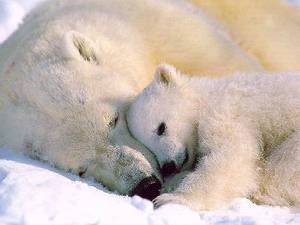Polar bears live in the Arctic along shores and on sea ice. Although there is much talk in the news about climate change and the loss of polar ice, preschoolers are too young to comprehend these facts without fear. Limit activities to facts about the lives of polar bears.
Have some fun introducing the topic by showing the children the picture you’ve drawn of the animal of the day – a blank piece of white paper. After kids have made their guesses, introduce the preschoolers to the joke that the paper shows a polar bear in a snowstorm!
Polar Bear Facts
Nationalgeographic.com provides a lot of amazing facts about polar bears, the largest of all bears. Instead of listing a lot of details, intersperse preschool games and activities that support the information; and, with hope, make it easier for kids to remember the details.
A male bear is called a boar and it can reach 10 feet in length and 720 to 1700 pounds. A female, or sow, is approximately 7 feet in length and can weigh 500 to 600 pounds. This is amazing since the one-to-three cubs the mother gives birth to in her snow den only weigh a pound each.
Pass around a one pound weight (or a canned good that is a pound) so the kids can feel how little a cub weighs. Then call up the children, one at a time, to demonstrate how many children (and adults) it takes to equal the weight of an adult bear.
Polar Bear Preschool Theme
Polar bears eat the seals that are available in their area. They hunt in a variety of ways. One way is to stalk across the ice and then pounce. In other cases they will wait at a seal’s breathing hole, waiting for the seal to surface. (They usually bite the head, a detail you can leave out.) Sometimes, polar bears will swim beneath the ice in search of seals.
Play a game of “Sneak up on the Seal,” which is similar to “Mr. Bear, Are You Awake?” One child is the seal resting on the ice. Provide the child with a chair that they can run behind, or dive under (if it is a large chair) to represent that they have escaped the polar bears. The other children are polar bears and they should stand at least 20 feet away from the seal.
The polar bears call out in unison, “Do you see any polar bears?” and the seal answers “yes” or “no.” If the seal says “yes” then the polar bears run and try to tag the seal while the seal tries to get behind or beneath the chair and to safety. Polar bears do not hunt in packs, so, if you have the space, you could have an equal number of seals and polar bears. (Provide a base for the seals to tag.)
Preschool Lesson Plan
Polar bears have clear, not white, fur. Demonstrate this optical illusion by holding up a sheet of clear plastic wrap. Then, give each child a strip of plastic wrap and have them roll in into a ball. Place the balls on a sheet of plastic wrap and then wrap them close. Hold up the result so the kids can see that a lot of clear pieces can create the illusion of something white.
The clear fur helps the bear to absorb sunlight. Their black skin holds onto that heat. The other thing that helps polar bears survive the Arctic cold is blubber. To show how fat protects against the cold, fill a quart-size plastic storage bag with vegetable shortening. Then, slide in a second bag and squash around the shortening so it is distributed evenly between the bags.
Provide two bowls of ice water. In one, the child places their bare hand. The other hand slides into the blubber bag, also set in the water. The shortening should make that hand feel less cold. Rotate to all of the children.
Rub some of the vegetable shortening on half a sheet of paper and then spray both halves with water. The protected side will repel water. Polar bears have oils in their fur that keeps them from getting soaked to the skin when they go in the water.
Polar bear preschool activities can help young children learn facts about the lives of these large bears. If it is wintertime and you have ice outside, you can try sliding different objects over the ice, showing how rough objects are like the pads on a polar bear’s paws and prevents it from slipping. Put on some slow music and finish with the children swimming in the air like polar bear that use their front paws to move them through the water as they steer with their back legs.
